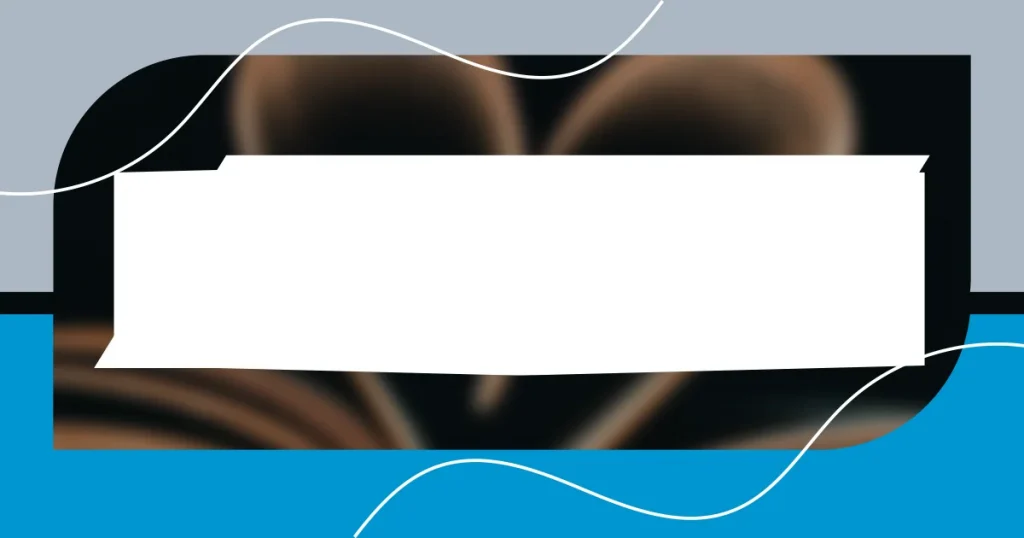Key takeaways:
- Understanding genre characteristics helps shape reader expectations and emotional responses, influencing how stories are perceived and experienced.
- Recognizing genre conventions, such as setting and narrative style, serves as a guide for identifying and navigating different types of storytelling, enhancing reader engagement.
- Exploring themes, tone, and audience expectations deepens appreciation of stories, revealing how genres can evoke diverse emotional landscapes and connect with universal human experiences.

Understanding genre characteristics
Understanding genre characteristics is pivotal in appreciating any form of storytelling. Each genre has its distinct conventions – for instance, the suspense in thrillers often hinges on twists and pacing, while romances traditionally focus on emotional connections and character development. I remember diving into a mystery novel for the first time; the intricate clues drew me in, and I found myself analyzing every detail critically. Isn’t it fascinating how certain elements evoke specific feelings in us?
Consider how the tone and mood differ across genres. When I first explored fantasy, the rich world-building and magical elements transported me to realms beyond my imagination. In contrast, reading a slice-of-life narrative grounded me in everyday experiences, painting a vivid picture of mundane moments as extraordinary. Isn’t it amazing how these characteristics influence our emotional journeys?
Notably, genre can also shift perceptions and expectations. When I pick up a horror book, I brace myself for fear and tension; yet, when I choose a comedy, I expect laughter and light-heartedness. Each genre comes with its own emotional contract between the reader and the author, shaping what we anticipate and experience. Can you recall a moment when a genre surprised you by defying its typical characteristics?

Recognizing genre conventions
Recognizing genre conventions plays a crucial role in navigating the landscape of storytelling. I’ve often noticed that certain elements can almost act like a cheat sheet when identifying a genre. For example, in science fiction, futuristic technologies and space explorations are prevalent conventions. The first time I read a sci-fi novel, I was captivated by the imaginative concepts. I remember feeling a blend of curiosity and excitement as I tried to understand the technological innovations described, which was a refreshing change from the more grounded settings I was used to.
When analyzing genre conventions, the setting often serves as a clear indicator. Take historical fiction, for instance; the nuanced details of a specific time period—including language, clothing, and societal norms—invite readers to step into a different era. I recall being immersed in a historical novel, feeling the weight of its time as if I were walking through the pages. This connection to the setting can profoundly impact our engagement with the story. Have you ever been swept away by a vividly described backdrop that transported you?
Expectations also play a significant role in how we perceive genre conventions. For instance, I find that thrillers often employ a fast-paced narrative with cliffhangers to keep the reader on edge. This contrasts sharply with the tranquil pacing that characterizes literary fiction, which encourages deep reflection. I vividly remember completing a thriller, my heart racing at every twist, while a literary piece left me in thoughtful contemplation for days. These conventions shape not just our reading experience but our emotional responses as well.
| Genre | Conventions |
|---|---|
| Sci-Fi | Futuristic technology, space exploration |
| Historical Fiction | Authentic settings, period-appropriate details |
| Thriller | Fast pacing, cliffhangers |
| Literary Fiction | Reflective pacing, emotional depth |

Analyzing themes and motifs
When I delve into analyzing themes and motifs in genres, I often find that they act as the backbone of a story, revealing deeper meanings beneath the surface. For instance, in dystopian fiction, I’ve noticed recurring themes of oppression and rebellion that resonate on a personal level, forcing me to reflect on the world around me. I still remember reading a novel where the protagonist’s struggle against an authoritarian regime left me feeling a mix of inspiration and hope—an emotional journey that stayed with me long after I turned the last page.
- Themes and motifs can connect us to universal human experiences, such as love, loss, and identity.
- In gothic literature, motifs like darkness and decay evoke a sense of dread and highlight the internal struggles of characters.
- Exploring how different genres use similar themes can reveal unique perspectives; for instance, both romance and tragedy might explore the theme of love, but their presentations differ significantly.
Understanding these underlying threads enhances my appreciation of storytelling, showing how the genre molds these essentials in distinct and powerful ways.

Identifying tone and style
Identifying tone and style is crucial when differentiating between genres, as both elements shape the reader’s entire experience. For instance, I recall reading a whimsical children’s book that was bursting with vibrant illustrations and playful language. The lighthearted tone immediately made me feel nostalgic, reminiscent of my own childhood tales, which emphasizes how tone can evoke specific emotions and memories.
When it comes to style, I often consider the author’s choice of language and sentence structure. I remember picking up a noir mystery filled with sharp, clipped sentences that mirrored the gritty world it portrayed. This distinctive style not only captured my attention but also enhanced the mood of the narrative, drawing me into its suspenseful atmosphere. Have you ever noticed how a single sentence can set the entire mood of a story?
Moreover, an author’s voice can serve as a lens through which the genre is viewed. I’ve found that the poetic prose in literary fiction instills a sense of introspection that draws readers deeper into the characters’ emotional landscapes. It reminds me of that one novel where I spent hours contemplating the lyrical depiction of sorrow—it left an indelible mark on my understanding of human emotion. This is how crucial identifying tone and style can be in appreciating the nuances within different genres.

Exploring audience expectations
Exploring audience expectations has always fascinated me, especially when considering how different genres shape what readers anticipate. For example, when I pick up a fantasy book, there’s an unspoken promise of adventure and magic. I remember diving into a series where I eagerly awaited epic battles and mythical creatures. This anticipation enhanced my reading experience, making every page thrilling.
There’s something intriguing about how genre conventions guide our expectations. With thrillers, I often find myself on the edge of my seat, expecting unexpected twists. I once read a psychological thriller that didn’t just deliver shock; it challenged my perceptions of trust and reality. How often do we realize that our eagerness for a startling ending can influence our emotional investment in the characters?
Additionally, understanding audience expectations can deepen my appreciation of a story’s craft. Take romance, for instance; I find that the classic “will they or won’t they” trope draws me in, making me root for the couple while I enjoy heartfelt moments. Reflecting on my experiences, I recall a particular romance novel that had me sobbing and cheering at the same time, proving how well-executed emotional arcs can resonate. In this way, genres not only set expectations but also connect us to shared experiences.

Comparing genre examples
When comparing genre examples, I often think about how certain features set them apart. For instance, science fiction feels like a ticket to the future. I remember reading a sci-fi novel where the world was filled with advanced technology and space exploration. The imaginative concepts completely transported me, pushing the limits of what I considered possible. Doesn’t it spark a sense of wonder about our own reality?
In striking contrast, I find historical fiction anchors me in a particular time and place. A while ago, I delved into a richly detailed historical narrative about a significant event. The author’s vivid imagery and meticulous research made the past leap off the page, almost as if I could feel the weight of history on my shoulders. So, how does the experience of stepping back in time differ from exploring an unknown future? It’s fascinating how genres can pull us in opposite directions, yet both engage us deeply.
When it comes to comparing tones, I think about children’s literature versus horror. Children’s books typically exude warmth and whimsy—like that one story about a curious little critter embarking on minor adventures. It brought me so much joy as a kid. Conversely, the chilling atmosphere of horror books creates a sense of dread. I still remember gripping a horror novel that left me feeling uneasy, with shadows creeping in my mind long after I turned the last page. How powerful is it that a single genre can completely shift our emotional landscape? Each genre leaves its unique imprint on our hearts and minds, revealing just how diverse storytelling can be.

Applying genre differentiation techniques
Applying genre differentiation techniques can be a game changer in how I engage with stories. For instance, I often analyze plot structure and character development as benchmarks. I once read a graphic novel where the blending of visuals and text created a rich narrative layer—something I hadn’t experienced before. This unique storytelling method made me realize how the medium itself can influence genre classification and reader expectations.
When I examine language and style, I always keep in mind how they shape my reading experience. I recall reading a horror short story filled with suspenseful, chilling prose. The author’s deliberate word choice drew me in, creating a palpable tension that kept me flipping pages, heart racing. This emphasizes the importance of tone; a well-crafted sentence can evoke emotions that are specific to the genre, pushing boundaries and enhancing engagement.
Another technique I find effective is exploring thematic elements. I remember a mystery novel where the protagonist’s personal journey intertwined intricately with the case. This layering of themes not only motivated the character but also enriched the narrative. Doesn’t it strike you how different genres can tackle the same themes in diverse ways? By delving into these elements, I’ve discovered that genre differentiation is not just about categorizing books; it’s about understanding the deeper connections that stories forge with their audiences.
















